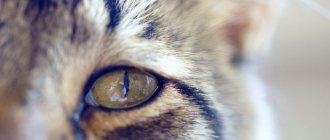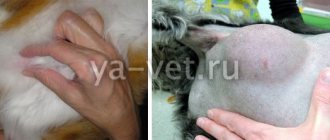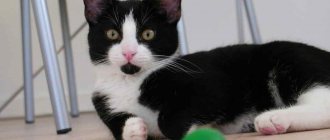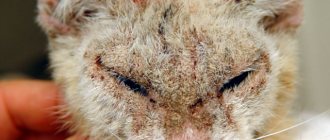Chronic rhinosinusitis in cats is a syndrome characterized by inflammation of the nasal passages and sinuses, resulting in constant or intermittent nasal discharge and sneezing.
The pathophysiology of chronic rhinotracheitis is not completely clear. Rhinosinusitis affects cats of any breed, age and gender. At the moment, chronic rhinosinusitis in cats does not have an exact cause. Diagnostic efforts should be aimed at excluding specific causes of nasal discharge and associated clinical signs.
Cats that have had respiratory viral infections in the past are at risk. Rhinotracheitis and calicivirus are common causes of acute upper respiratory tract infection in kittens and adult cats. The acute period of infection usually passes, but the rhinotracheitis virus does not leave the cat’s body, and it becomes a latent carrier. Similarly, cats can remain carriers of calicivirus for many years.
Latent infection can manifest itself, especially during times of stress. The role of active viral infection in the pathogenesis of rhinosinusitis has not been documented.
Viral infection can lead to cytolysis and subsequent damage to the protective mechanisms of the nasal mucosa. This, in turn, predisposes to the occurrence of secondary bacterial infection.
The nasal passages and sinuses are usually nonsterile and contain a wide range of microorganisms, including some types of streptococci, staphylococci, corynebacteria, pasteurella, klebsiella, enterobacter, Escherichia coli, and Pseudomonas aeruginosa. Bacterial infection in cases of chronic rhinosinusitis in cats is likely secondary rather than primary.
Rhinotracheitis, calcivirosis and other upper respiratory tract infections
Feline upper respiratory tract infection is a general term for respiratory infections caused by one or more viral or bacterial agents.
The infection may be caused by one or more viral and/or bacterial agents. The most common viruses that cause upper respiratory tract infections in cats are:
- Herpesvirus type 1 is also known as feline rhinotracheitis virus or FVR.
- Calcivirosis (FCV).
The most common bacteria that cause upper respiratory tract infections in cats are:
- Bordetella bronchiseptica.
- Chlamydophila felis.
Rhinotracheitis and calcivirus cause approximately 90% of all secondary respiratory tract infections in cats. Other, less common pathogens that can lead to purulent discharge and inflammation of the nose are:
- Mycoplasmosis.
- Rotavirus.
Feline rhinotracheitis
Animal owners often come to us with the question: Do cats have a runny nose, do they get the flu, like humans?
Today we will talk about feline rhinotracheitis - a disease that occurs very often and causes a lot of problems for the pet.
Rhinotracheitis or feline herpes virus infection
(the virus belongs to the herpesvirus family, hence the name) is an acute, highly contagious viral infection transmitted by airborne droplets and through contact between cats (during games, licking each other, through grooming products.) Young animals and kittens are most often affected, In adulthood, the disease can be more severe than in youth.
The main complaints with which animal owners turn to a veterinarian: their beloved cat has become lethargic, constantly lies down, does not play, sneezing is often noted, crusts form on the nasal mucosa, the cat rubs its muzzle and tries to scratch its nose, eyes. Purulent, gray, yellow discharge is noted from the eyes; the eye seems to be covered with a film. Appetite is often weakened or absent. This is due to the fact that due to rhinitis, cats have difficulty smelling odors that stimulate appetite, and elevated temperatures, like in humans, discourage the desire to eat.
When examined by a doctor, the following is revealed: acute purulent/catarrhal rhinosinusitis, blepharospasm, conjunctivitis, ulcerative herpetic keratitis, often animals experience fever, body temperature rises to 41-41.5 C (at normal 38.0-39.5 C). In adult animals, one leading symptom often dominates: chronic rhinosinusitis, or ulcerative herpetic keratitis, which can last for months without causing fever or general lethargy.
Diagnostics
Many viral and bacterial diseases of cats and oncological diseases can give similar symptoms: feline chlamydia, feline calicivirus, nasal tumors in adult animals. In order to diagnose rhinotracheitis, our doctors take a swab from the nasal cavity, from the eyes, and use the polymerase chain reaction (PCR) to isolate the DNA of the pathogen from this material. Since the technical feature of PCR diagnostics requires 3-5 days to obtain the result, we begin treatment immediately, because 3-5 days can cause irreversible changes in the body. In this case, the diagnosis only confirms our preliminary diagnosis.
Treatment
For treatment, it is mandatory to use antipyretic drugs at high temperatures to restore water and electrolyte metabolism. During a fever, cats experience a large consumption of fluid in the body; this must be replenished until the animal begins to eat and drink on its own. Antibacterial drugs, immunomodulators, vitamins, and local treatments (sanitation) of the nose and eyes are required. For herpetic keratitis, drops are administered 4-5 times into the eyes over several weeks.
How not to get sick?
Vaccination of cats against rhinotracheitis can protect the animal from severe illness, while the cat can become infected and get sick in a mild form, without complications. First of all, this applies to those animals that have free range or live on the street. Vaccinated cats kept in apartments rarely develop rhinotracheitis. In this case, the risk of a domestic cat getting sick increases if you pick up another kitten from the street, from the poultry market.
Vaccination of cats is carried out from 8 weeks of age - twice, with an interval of 3-4 weeks, then annually.
Look at your pet's passport; vaccinations must have been completed within the last year.
Symptoms of upper respiratory tract damage
Nasal discharge, even if it is purulent, is a very “vague” symptom that does not provide a complete picture for diagnosis. Typically, if a cat's nose is “running,” the inflammation affects the throat and eyes, so secondary symptoms include:
- Sneezing and nasal congestion.
- Cough.
- Labored breathing.
- Swelling of the mucous membranes.
- Conjunctivitis.
With rhinotracheitis and calcivirosis, the cat may develop ulcers in the mouth. Additional symptoms are:
- Fast weight loss.
- Lethargy.
- Fever.
- Enlarged lymph nodes.
- Blepharospasm (squint).
Routes of infection
The causative agents of rhinotracheitis and calcivirosis are widespread. The carrier spreads the virus throughout the environment through saliva, nasal discharge, feces and urine. Vaccinated cats become infected through contact with carriers. Animals that have not received vaccination are at risk of getting sick from contact with soil, water and environmental objects.
In most cases, cats become infected through direct contact with a carrier, as viruses and bacteria can survive in the environment for up to 18–24 hours. The danger of rhinotracheitis and calcivirosis is that a visually healthy (recovered) animal can remain a carrier for a long time.
Dermatological diseases
The cat's body is susceptible to autoimmune diseases. In such cases, the immune system attacks the body's own tissues where the target cells are located. Dermatoses of this type include:
- Pemphigus foliaceus. The intercellular epidermal tissue is affected, which leads to the appearance of pustular rashes on the face. May be accompanied by hyperthermia, lethargy, and refusal to eat. A biopsy of the affected areas is necessary.
- Common pemphigus. The epidermis stratifies with the formation of bubbles filled with liquid, which burst, turning into ulcers on the nose, lips and in the oral cavity. May be fatal. A histological examination of the damaged mucosa is required.
- Erythematous pemphigus. Most often, only the nose is affected. Accompanied by pigmentation disorders, rashes, ulceration of the nasal planum, bridge of the nose and bridge of the nose, and the formation of scabs.
- Pemphigus vegetans. A relatively mild form of dermatosis. Main symptoms: rash and blisters.
- Systemic lupus erythematosus. Skin manifestations are observed in the discoid form, involving the nose, ears, eyelids, lips. The process begins with changes in pigmentation and redness, then ulcers form. Systemic disorders include: damage to the hematopoietic system (anemia, decreased blood clotting), kidneys, joints, gastrointestinal tract, central nervous system. Tests for antinuclear antibodies and a biopsy of the epidermis are necessary.
- Vasculitis. The disease affects blood vessels, which leads to a deterioration in the blood supply to tissues and their subsequent death. Most often, the nose, lips, tip of the tail, ears, paw pads, and genitals are affected.
- Cold agglutinin disease. Reason: at low ambient temperatures, red blood cells interact with immunoglobulins. The same areas are damaged as with vasculitis. They acquire a bluish coloration, pigmentation is disrupted, and hair falls out. In severe cases, necrosis may occur.
If these symptoms appear, you should contact your veterinarian as soon as possible. He will prescribe the necessary tests, conduct an examination and make a diagnosis. Treatment of autoimmune diseases is a complex and lengthy process, including therapy with corticosteroids and immunosuppressants.
Treatment and prevention
In most cases, unless the upper respiratory tract infection is complicated by secondary diseases, the cat can be treated at home. For complex therapy the following are prescribed:
- Immunostimulants.
- Nasal, ear and eye drops.
- For purulent nasal discharge, antibiotics are prescribed.
- For specific fungal infections, narrow-spectrum drugs are prescribed (destroying only the pathogen).
To speed up the healing process, it is recommended to maintain normal air humidity. In summer and winter, a humidifier will help cope with this task. If the cat cannot breathe through its nose, steam therapy is indicated once a day for 10–15 minutes.
Prevention of purulent nasal discharge and upper respiratory tract infections:
- Protecting cats from contact with stray animals and unsupervised walking.
- Vaccination according to schedule.
- Balanced diet.
- Compliance with the rules for keeping animals.
- Regular preventive examinations at home.
- Preventive visits to the veterinarian at least once every six months.
Prevention of nasal suppuration in cats
Prevention consists of creating optimal living conditions, proper care of the pet, timely hygiene, and systematic examinations of the cat’s nasal cavity.
Attention is paid to the diet, since unbalanced feeding reduces the immune potential of animals. To prevent your cat from contracting a dangerous infection, do not neglect preventive vaccinations, revaccinations, and dewormings.
Other causes of purulent nasal discharge
There are many reasons why a cat's nasal discharge may become purulent. In addition to viral infection, you need to exclude:
- Nasal polyps are benign neoplasms that arise as a result of modification and proliferation of the tissues of the mucous membranes.
- Bacterial infection (post-viral rhinitis). A bacterial infection occurs after rhinotracheitis, as a result of which the mucous membranes of the nasal cavity are damaged, which allows bacteria to enter the body.
- Fungal infection – cryptococcus and aspergillosis are fungal infections that parasitize the nasal passages and sinuses of cats.
- Malignant tumors affecting the upper respiratory tract and skull.
- Head injury.
- Entry of foreign objects into the respiratory tract.
- Allergies.
- A cleft palate is a congenital defect.
- Nasopharyngeal fistula is a consequence of an advanced inflammatory process.
- Cheyletiellosis is a tick-borne disease in which parasites can get into the sinuses.
- Diseases of teeth and gums.
- Pneumonia.
Diagnosis of rhinosinusitis
To make a diagnosis of chronic rhinosinusitis in cats, it is necessary to exclude other causes of diseases of the nasal cavity and sinuses.
The differential diagnosis for cats with acute, short-duration symptoms is different from that for cats with chronic, persistent, or recurrent symptoms.
Differential diagnoses for cats with chronic signs include nasal neoplasia (most commonly lymphoma and carcinoma). Fungal rhinitis (usually cryptococcosis). Periodontitis, nasopharyngeal polyps and foreign bodies in the nasal cavity.
Differential diagnoses for an acute process include all those mentioned above for cats with a chronic course of the disease, as well as herpesvirus, calicivirus, chlamydia, and bordetellosis.
Routine tests, such as complete clinical and biochemical blood tests, complete clinical urine analysis, and serological tests are useful in determining general health status, but do not contribute to the diagnosis of this clinical syndrome.
X-rays and computed tomography may not be very informative. Sometimes there is a change in the normal shape of the turbinates, and an accumulation of secretions in the sinuses.
Bacteriological culture of swabs can determine the bacterial microflora, but does not prove the leading role of microbial infection.
During rhinoscopy, either no changes are detected, or mucus and hyperemia are observed in the affected nasal passages. Sometimes during rhinoscopy, destruction or curvature of the nasal turbinates is visualized.
A biopsy may reveal neutrophilic or lymphoplasmacytic inflammation. This is most useful for differential diagnosis, including neoplasms.











